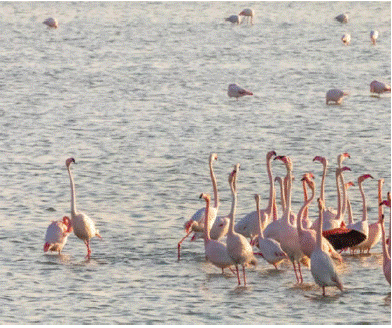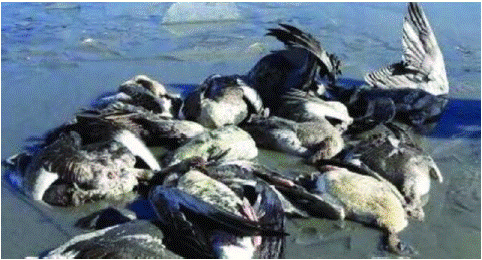
Mini Review
Austin J Environ Toxico. 2024; 10(1): 1049
Ecological Concern with Evaporation Ponds Used in Renewable Energy Plants: A Mini-Review
Abdeljalil Adam*; Nabil Saffaj; Rachid Mamouni
Laboratory of Biotechnology, Materials, and Environment, Faculty of Sciences, University IBN ZOHR, Agadir, Morocco
*Corresponding author: Abdeljalil Adam Laboratory of Biotechnology, Materials, and Environment, Faculty of Sciences, University IBN ZOHR, Agadir, Morocco. Email: adam.abdeljalil@gmail.com
Received: February 22, 2024 Accepted: March 26, 2024 Published: April 02, 2024
Abstract
Numerous renewable energy facilities utilize evaporation ponds as the ultimate disposal method for their wastewater. Several studies focusing on environmental impacts and considerations have endorsed this approach as a means to prevent the direct release of industrial wastewater into surface water bodies, thus mitigating water pollution. Nevertheless, adopting this solution might give rise to significant environmental and ecological challenges.
This paper will delve into the drawbacks associated with utilizing evaporation ponds as a means of wastewater discharge. It will specifically focus on these disadvantages within the context of environmental and ecological considerations.
Keywords: Evaporation Pond; Wastewater; Ecological challenges.
Introduction
The 21st century continues to confront significant challenges, notably the irreversible depletion of vital natural resources, especially water, and the degradation of its quality [1].
Africa heavily relies on conventional water resources. However, in recent times, the region has introduced non-conventional water sources like desalination, water reuse, and recycling of treated wastewater. These measures aim to curtail the demand for natural resources and uphold environmental preservation [2].
Evaporation ponds (Figure 1) are specifically designed, lined earthen basins where solar irradiation causes the natural evaporation of concentrated substances. As freshwater evaporates from these ponds, the minerals within the concentrated solution crystallize into salts, which are periodically collected and transported off-site [3].

Figure 1: Evaporation Pond illustration.
In countries characterized by arid and warm climates, elevated evaporation rates, and affordable land, evaporation ponds can serve as an effective choice for managing industrial wastewater disposal. These ponds can be effectively lined to mitigate the risk of groundwater pollution.
Notwithstanding these advantages, the utilization of evaporation ponds could potentially give rise to a number of environmental and ecological issues. For instance, any potential overflow of wastewater from these ponds has the potential to cause significant harm to the ecosystem, leading to contamination of soil and groundwater. Additionally, due to their open water nature, evaporation ponds can attract birds and animals (Figure 2), thereby potentially elevating mortality rates among these species if the quality of the contained wastewater is inadequate and surpasses permissible limits [4].

Figure 2: Evaporation Pond illustration.
Water is an essential requirement for birds, comparable in importance to their need for sustenance. Similar to how we utilize water for diverse purposes, birds also have a multitude of uses for this vital resource. Apart from satisfying their thirst and rehydrating, water plays a crucial role in aiding birds with tasks such as preening, cleansing their feathers, and even eliminating parasites from their bodies.
This paper aims to illustrate the ecological challenges faced by industrial sites that previously relied on discharging their wastewater into evaporation ponds.
Methodology
We conducted a thorough search across the PubMed, Scopus, and Web of Science databases to retrieve articles that encompass the keywords: industrial effluent, Ecology, and renewable energy. Our search encompassed a variety of publication types, including special messages, reviews, books, and research projects, all focused on the subject matter. The scope of our search was limited to materials published within the last three years.
Results & Discussion
Birds often face challenges in locating water, particularly during specific periods of the year. Drought conditions can prove to be particularly challenging for avian species that predominantly consume dry foods, such as seeds with minimal moisture content. Introducing a water source can serve as a highly effective alternative to traditional bird seeds.
The physicochemical properties of the wastewater dumped into the evaporation pond have been examined by numerous researchers, and the results of evaluating the physico-chemical characteristics of wastewater discharged into the evaporation pond reveal that the process of evaporation has a negative impact on these industrial effluents. This is evident from a noteworthy elevation in multiple parameters of the wastewater. This effect has the potential to bring about adverse consequences for the environment and ecology.
The heightened levels of EC (electrical conductivity) observed in the evaporation ponds wastewater can be attributed to the biodegradation occurring in this environment. This phenomenon is closely linked to the escalation of various physicochemical parameters. EC experiences augmentation when there is a notable presence of organic pollution caused by birds and animals attracted.
The increased content of TSS (total suspended solids) in the evaporation pond may also be attributed to the oxidation of Fe ions when exposed to atmospheric oxygen.
Given the findings of earlier studies, it is evident that evaporation ponds may contain some contaminants. Additionally, because animals and species are drawn to the surface water, wastewater discharged into evaporation ponds may have an adverse effect on ecosystems and may even result in death of some species (Figure 3) [5].

Figure 3: Bird mortality.
Renewable power plants should take into account this significant ecological concern stemming from the discharge of wastewater into evaporation ponds. To address this issue in an environmentally responsible manner, a sustainable and ecologically sensitive approach would involve the adoption of strategies for recycling the wastewater instead of allowing it to be released into evaporation ponds. This proactive measure aims to not only prevent the potential negative impacts of evaporation ponds on the local ecosystem but also to reduce the mortality of species that are drawn to these ponds.
Conclusion
It is imperative for renewable power plants to consider the notable ecological issue associated with the release of wastewater into evaporation ponds. In order to tackle this matter in an ecologically conscientious manner, a sustainable and ecologically mindful strategy would need the implementation of measures aimed at recovering the wastewater, rather than permitting its discharge into evaporation ponds. The implementation of this preventive technique seeks to mitigate the possible adverse effects of evaporation ponds on the surrounding ecosystem, while also decreasing the mortality rate of species attracted to these ponds.
References
- Adam, & Saffaj. (2023, December). Solar Still Technology Advancements for Recycling Industrial Wastewater with Renewable Energy: A Review. 2023.
- Adam A, Saffaj N, Mamouni R. The reliability of evaporation ponds as a final basin for industrial effluent: Demonstration of an environmental risk management methodology. MethodsX. 2023; 10: 102055.
- Adam A, Saffaj N, Mamouni R. Classification of industrial wastewater discharged into effluent pits, an approach toward a sustainable recycling: case study of a water treatment facility in Morocco. E3S Web of Conferences. 2023; 364: 02001.
- Abdeljalil A, Nabil S, Rachid M. Feasibility and sustainability of evaporation ponds as final basins for industrial wastewater: statistical evaluation of gross parameters. Desalination And Water Treatment. 2022; 257: 41–54.
- Ansari A, Golabi MH. Prediction of spatial land use changes based on LCM in a GIS environment for Desert Wetlands – A case study: Meighan Wetland, Iran. International Soil and Water Conservation Research. 2019; 7: 64–70.